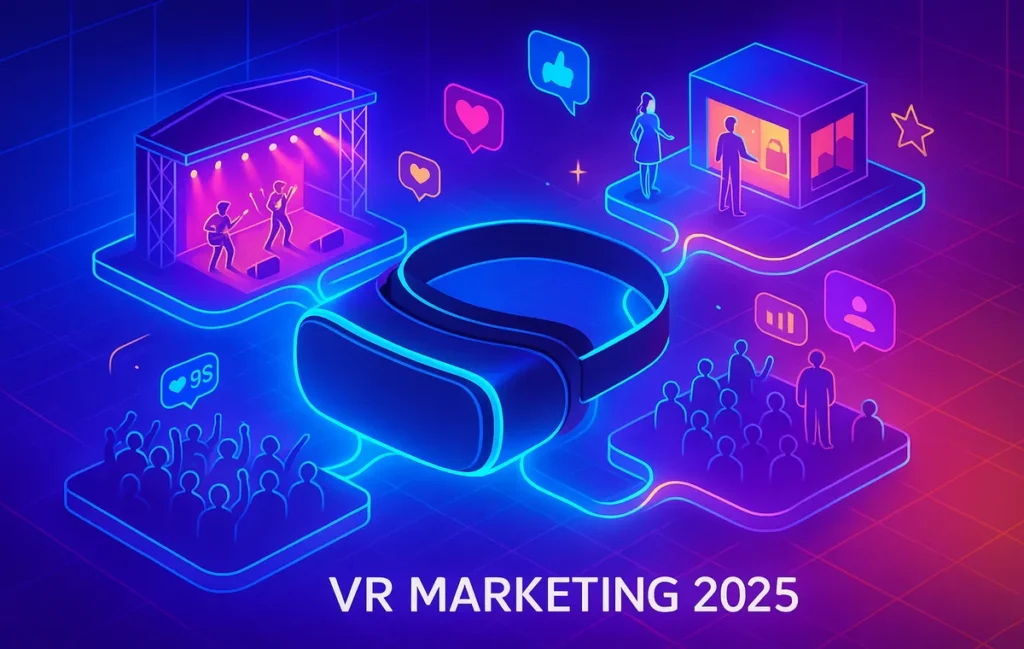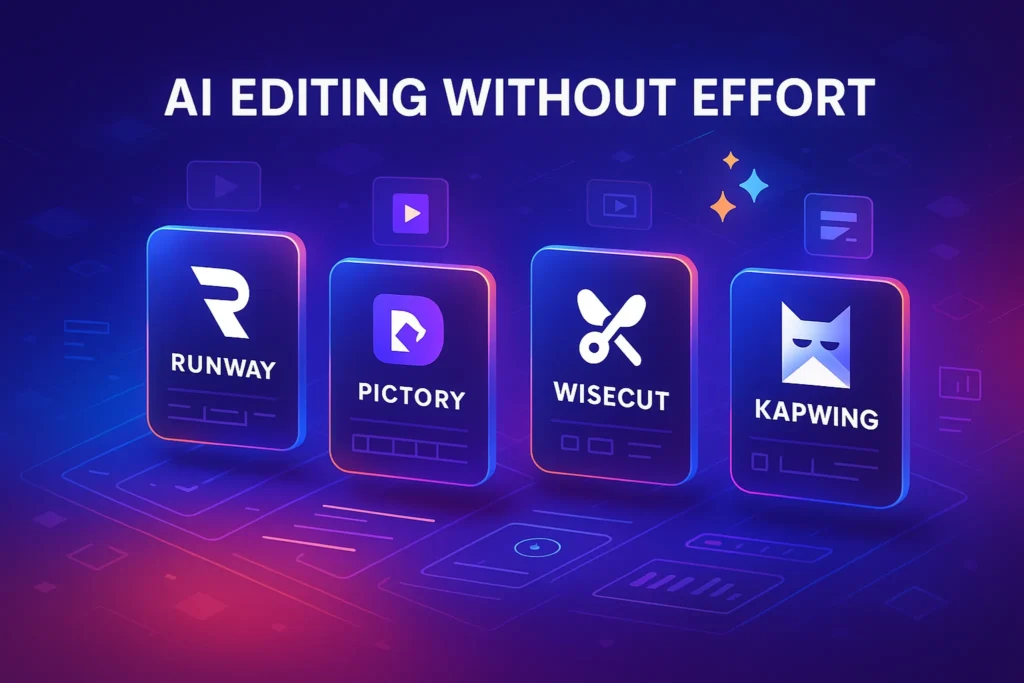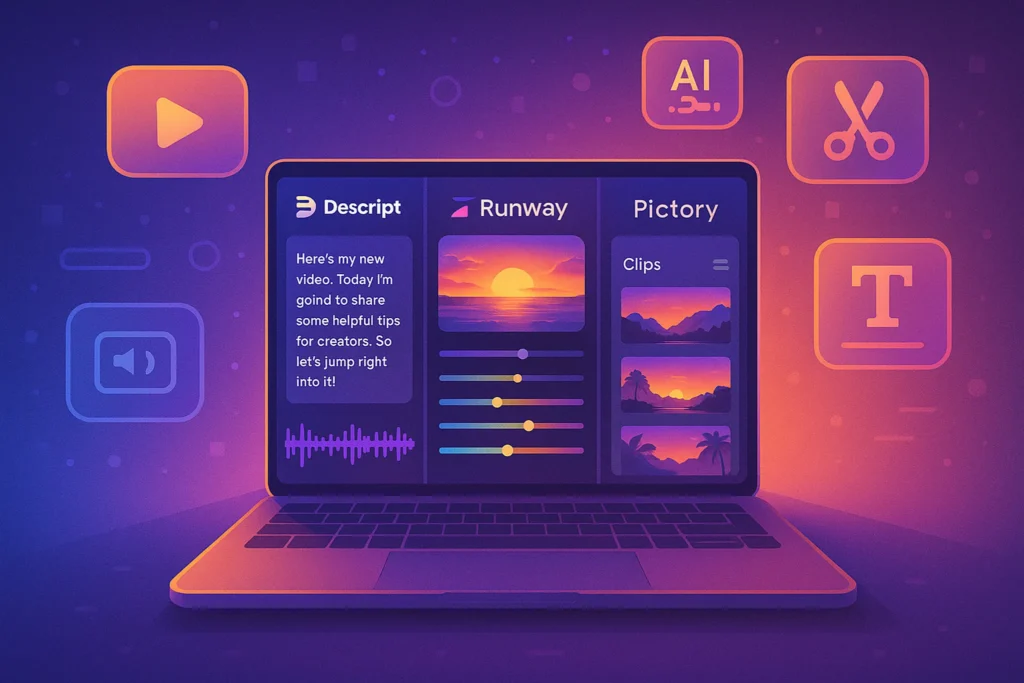🚀 Introduction: Why VR Marketing Matters in 2025
The shift from flat-screen advertising to fully immersive experiences is no longer a futuristic dream. In 2025, brands are not just creating videos for YouTube or TikTok; they are building entire interactive universes where consumers can walk, engage, and participate. Virtual reality (VR) marketing strategies are redefining how companies connect with audiences. Platforms like Meta Horizon Worlds, Roblox, and VRChat have transformed into fertile playgrounds for storytelling, events, and brand engagement.
At its core, VR marketing is about presence—the ability to make a consumer feel like they are inside the brand’s world. Instead of passively watching a campaign, users interact with it, shaping how they remember and value the brand. When you compare this with traditional campaigns, the contrast is staggering. A video ad may last 30 seconds, but a VR event can keep users engaged for 15–30 minutes, significantly increasing dwell time, brand recall, and emotional connection.
💡 Nerd Tip: Think of VR marketing not as a campaign, but as a destination where your audience wants to spend time.
🎮 Immersive VR Experiences: Horizon Worlds, VRChat & Virtual Events
One of the most powerful VR marketing strategies today is the use of immersive environments. Meta Horizon Worlds, VRChat, and Fortnite Creative are no longer just games or platforms—they are venues for experiences. Coca-Cola, Nike, and Gucci have already experimented with custom VR worlds where users explore branded spaces, try virtual products, or attend interactive events.
Take Meta Horizon Worlds as an example. In 2024, a live VR concert hosted there drew over 1.2 million participants, with users engaging with branded stages, custom skins, and virtual merch. In VRChat, influencers are already building communities where brands sponsor lounges, skins, and even interactive billboards. The beauty of this approach is that it integrates seamlessly into the culture of the platform—ads don’t feel like ads; they feel like part of the experience.
For B2B, VR is equally promising. Virtual trade shows, immersive product demos, and training simulations allow brands to reduce travel costs while increasing global reach. Imagine walking through a digital factory in VR where each machine displays AR-style data, helping potential clients visualize the value of an industrial product.
Here’s where internal synergies matter. If you’ve read our piece on Top Video Ad Platforms in 2025, you’ll notice how much of today’s targeting tech is built for 2D ads. VR platforms are the next evolution—an ecosystem where traditional ad placements evolve into interactive 3D touchpoints.
🌀 AR Overlays & 3D Ads: Bridging Real and Virtual Worlds
While VR dominates immersion, augmented reality (AR) ensures campaigns scale across everyday devices. Snapchat’s AR Lenses, TikTok’s Branded Effects, and Apple’s ARKit overlays are turning smartphones into marketing canvases. In 2025, this is no longer gimmicky—it’s standard.
Brands now deploy 3D interactive ads that let users test products in real space. A furniture brand, for example, can let you drop a virtual sofa into your living room through AR before you buy. TikTok’s Branded Effects campaigns in 2024 showed a 23% higher engagement rate than traditional video ads, proving AR isn’t a novelty but a performance driver.
The crossover between VR and AR is creating mixed-reality funnels. A user might discover a brand via TikTok AR effects, then dive deeper by attending a VR launch event in Horizon Worlds. That continuity creates a layered experience that keeps the audience engaged longer than any banner ad or short clip ever could.
💡 Nerd Tip: Always think in 3D continuity. Start with AR for reach, then lead users into VR for depth.
📊 Measuring Success: Metrics & ROI in Immersive Campaigns
One of the biggest challenges in immersive marketing is measurement. Traditional metrics—impressions, clicks, conversions—don’t capture the nuance of being inside a branded world. Instead, VR and AR campaigns use metrics like:
-
Engagement duration (time spent inside a branded world).
-
Interaction depth (number of virtual objects engaged with).
-
Emotional sentiment (captured via AI-based voice and gesture analysis).
-
Conversion proxies (e.g., QR scans or integrated purchase links).
Benchmarks from 2024 show that immersive campaigns often yield 35–45% longer engagement times compared to video ads. A VR product demo, for example, can increase purchase intent by up to 27% compared to a static ad.
Here’s the catch: ROI requires patience. Unlike performance ads where you measure click-through rates instantly, immersive campaigns generate brand lift over weeks or months. To calculate ROI, marketers must integrate VR analytics with CRM and attribution models.
Our earlier article on Social Media Marketing in 2025 explained how platforms like TikTok and LinkedIn optimize for short bursts of attention. VR flips this logic—its strength is in depth, not breadth. The real ROI isn’t just clicks but memory, loyalty, and advocacy.
⚖️ Risks & Scalability: Adoption, Costs & Cultural Fit
Despite its promise, VR marketing comes with risks. The first is adoption rate. In 2025, VR headset penetration has grown but still hovers around 18% of global internet users. That means immersive campaigns often target niche but high-value audiences.
The second challenge is cost. Building a branded VR world can cost anywhere from $50,000 to $500,000, depending on complexity. Compare this with a TikTok video campaign that may cost under $20,000, and the entry barrier is obvious. Smaller brands often hesitate, fearing that VR is “too expensive” or “too early.”
Yet, there are smart ways to scale. For example, instead of building a full Horizon World, brands can sponsor existing VRChat communities or use prefab environments that reduce costs. Moreover, AR overlays are cheaper to deploy, reaching broader audiences through smartphones before moving them into deeper VR experiences.
💡 Nerd Tip: Don’t treat VR as a replacement for your ads—see it as an upgrade path for your most loyal and engaged fans.
🎯 From Storytelling to Storyliving: Why This Works
Storytelling has always been at the heart of marketing. But VR pushes us into the era of storyliving, where the audience doesn’t just listen—they participate. A campaign isn’t about broadcasting a message; it’s about inviting someone into a world where the message is experienced directly.
For example, instead of telling users about the sustainability of your sneakers, you let them walk inside a VR rainforest restoration project that your brand supports. Instead of showing them a video of a car, you let them drive it through a VR city, testing speed, design, and features in real time.
This is where immersive marketing ties directly to concepts we’ve explored in Storytelling in Content Marketing. VR doesn’t replace storytelling; it evolves it. The result is a brand memory encoded as experience—something users are far less likely to forget.
⚡ Ready to Build Immersive Campaigns?
Explore VR ad builders, AR overlay platforms, and immersive storytelling tools. From Horizon Worlds to TikTok Branded Effects, start creating campaigns that people remember.
🧠 Consumer Psychology: Why VR Feels So Real
VR is powerful not just because of visuals, but because of how the brain perceives presence. Studies show that the human brain struggles to distinguish between VR experiences and real-life memories when immersion reaches a certain level. This means a branded VR adventure can literally encode itself as memory, not just marketing exposure.
The concept of embodiment—where users feel their virtual body as their own—creates deeper emotional bonds. When a user picks up a branded object in VR, their motor cortex fires as if they held it in reality. This is why VR marketing achieves recall rates up to 30% higher than traditional advertising.
From a brand perspective, this translates into loyalty. Customers don’t just remember your product; they remember living with it. That’s a level of impact no billboard can achieve.
📚 Case Studies: Successes and Failures
Success story: Gucci Garden on Roblox was one of the most cited examples of immersive brand marketing. Users explored digital exhibits tied to Gucci’s heritage, and some virtual bags sold for over $4,000 on secondary markets—higher than their real-life counterparts. The campaign showed how digital scarcity and immersive storytelling could blend into tangible brand value.
Failure story: A lesser-known auto brand in 2023 spent heavily on building a VR test-drive app, but neglected UX. Navigation was clunky, environments felt empty, and users abandoned the experience within minutes. Despite high spend, the campaign generated little ROI. The lesson? Immersion isn’t about flashy 3D models—it’s about crafting a meaningful experience.
💡 Nerd Tip: Don’t just build VR assets; build emotional journeys that align with how users want to explore your brand.
🤖 AI & Personalization in VR Marketing
The next layer of VR marketing in 2025 is AI-driven personalization. Imagine entering a VR showroom where the virtual assistant isn’t generic but adapts to your preferences, tone, and past purchases. AI-powered NPCs (non-player characters) can now converse naturally, guiding users through experiences tailored in real-time.
This is also where generative AI comes in. Instead of static environments, brands can let AI create adaptive worlds. For example, a sportswear brand might let the user run inside a personalized VR marathon in their own city, with AI generating the scenery dynamically.
Integration with AI analytics also unlocks hyper-targeting. Motion tracking, eye gaze, and even voice tone become data points for optimizing campaigns. While we explored AI’s role in The Future of Content Creation, its integration with VR shows how ads become living ecosystems that respond to users rather than just talking at them.
⚠️ Regulation & Ethics: The Dark Side of Immersion
With great immersion comes great responsibility. VR and AR campaigns collect massive amounts of data—from hand gestures to eye movements, even subtle emotional cues. This raises serious privacy and ethical concerns.
In 2025, regulators in the EU and U.S. are already debating rules for biometric advertising data. The concern is simple: should brands be allowed to track where you look in VR, how long you focus on an object, or whether your voice betrays excitement or hesitation?
Beyond privacy, there’s also the question of mental health. Overly manipulative immersive ads risk blurring lines between entertainment and reality, especially for younger audiences. Brands that embrace VR must ensure transparency, clear opt-ins, and ethical guidelines if they want long-term trust.
🛠️ A Practical Roadmap: How Brands Can Enter VR Marketing
For businesses wondering where to start, here’s a three-step entry path into immersive campaigns:
-
Start Small with AR Filters: Leverage Snapchat or TikTok branded effects. This requires low cost, reaches mass audiences, and tests creative ideas quickly.
-
Expand into Sponsorships: Partner with VRChat communities or sponsor existing Horizon Worlds events. This builds presence without massive development overhead.
-
Create Dedicated Experiences: Once your brand sees traction, invest in custom VR environments—whether that’s a showroom, a festival, or a gamified journey.
This staged approach ensures that brands don’t burn budgets prematurely but still position themselves early in the immersive marketing curve.
💡 Nerd Tip: Treat VR as a scaling funnel, not a one-off stunt. Begin wide with AR, then go deep with VR.
📬 Want More Smart VR Insights Like This?
Join our free newsletter and get weekly insights on immersive marketing, AI tools, and content strategies—delivered straight to your inbox. No fluff. Just high-quality content for creators and brands.
🔐 100% privacy. No noise. Just value-packed content tips from NerdChips.
🧠 Nerd Verdict
VR marketing strategies in 2025 prove that we are moving from storytelling to storyliving. The power of immersive campaigns lies in their ability to make people not just see or hear, but feel and participate. Yes, adoption barriers remain, and costs are higher than video ads, but the brand loyalty generated through immersive experiences is unmatched. For creators, founders, and marketers who want to be remembered, VR and AR are not optional experiments—they’re the next frontier of brand building.
❓ FAQ: Nerds Ask, We Answer
💬 Would You Bite?
If your audience could walk inside your brand story instead of watching it, would you let them?
And if the answer is yes—what kind of world would you create first?
Crafted by NerdChips for creators and teams who want their best ideas to travel the world.



